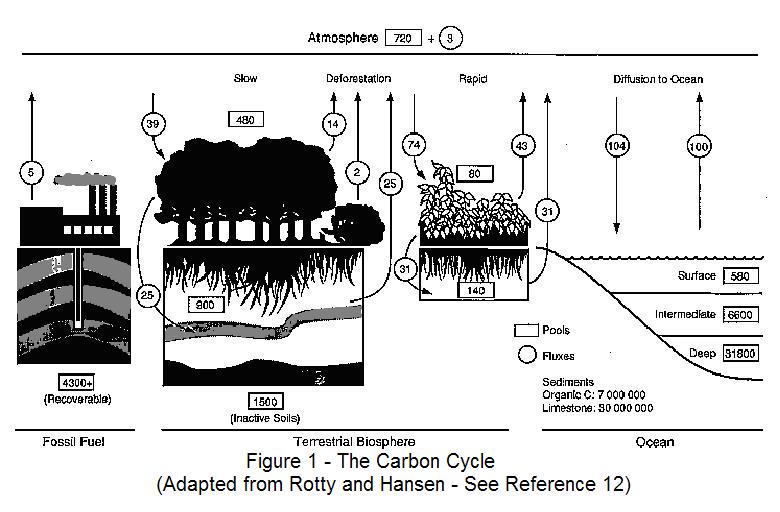Charcoal Carbon Sink and Greenhouse Gas Management
Duane Pendergast, October 20, 2004
Mother Earth’s carbon cycle provides
insights into processes humans could develop and modify to mange atmospheric
greenhouse gas emissions through the establishment of carbon sinks. Diagrams of
the carbon cycle show that earth’s non-human life cycles much more carbon to
and from the atmosphere each year than humans release through use of fossil
fuels. 
However, so far, thinking on this topic seems peculiarly convoluted, constrained and contorted. Some of the seemingly illogical policies with respect to possible sinks and sequestration which ensue are discussed on this website in the context of a submission[1] to the Government of Canada’s Offset Consultation Discussion Paper.
Most discussions of agricultural and forest sink concepts suggest that they will be limited by the decay of organic materials through natural processes turning them back into carbon dioxide, methane and other gases which are soon released to the atmosphere. I’ve been intrigued for some time with the possibility that the formation of decay resistant charcoal could be an important part of natural processes and that humans might be able to capitalize on that to establish major carbon sinks.
A couple of years ago, I thought there could be a patent opportunity in this idea and undertook a literature and patent search. I found some limited information - just enough to discourage my quest for a patent.
A similar search undertaken recently yields quite a different result. There are many references to the possible use of charcoal as a soil amendment and carbon sink. One of the references I found two years ago has now developed a substantial website[2] with ambitious aspirations. Their primary goal is to develop technology to produce hydrogen from organic materials along with charcoal for agricultural purposes. Another source[3] of information from my earlier quest focuses more on the production of charcoal with a cautious mention of “agricultural charcoal”. Some scientists[4] are investigating the role of human activity, fire, and charcoal in the development of dark soils in the tropics. Others[5] are looking into the role charcoal might play in enhancing soil productivity.
I also reviewed Climate Change 2001: Third Assessment Report on Climate Change[6] for information on the topic. A thorough text search of the entire publication of thousands of pages yields no mention of charcoal, black carbon, pyrogenic carbon, or inorganic carbon as a possible carbon sink. The 24 references to “charcoal” focus on its use as fuel. “Black carbon” is mentioned 143 times with the focus on aerosols and their effect on radiative absorption. There is a single reference to slowly decaying black carbon in soils. Inorganic carbon is mentioned 12 times in the context of dissolved carbon in the ocean. Three references to “pyrogenic” refer to methane production. Apparently the over 1000 contributors and reviewers of Climate Change 2001 overlooked the possibility of anthropogenic carbon sequestration in soil using charcoal. An IPCC report[7] on soil carbon stocks prepared in July, 2003 is similarly shy of references to charcoal in soil sinks. I’m looking forward to the next IPCC Assessment report due in 2007 as the concept is receiving more attention.
It seems now that the Kyoto Protocol will not be implemented as Russia has indicated reluctance and Europeans are starting to exhibit question their involvement. Perhaps this will allow some relaxation of pressure to find a quick and unproductive solution. Thinkers, scientists, engineers, and policy makers will have time to come up with a better plan should human induced climate change be confirmed. It seems this recent attention to developing a method of carbon sequestration that might simultaneously enhance earth’s soil is a worthy idea to be considered and studied.
The deliberate human preparation of charcoal for agricultural purposes as a means to manage greenhouse gases will require energy input. The concept thus fits well in Computare's mission.
![]()
[2] Eprida, 4523 Runnemede Rd, Atlanta, GA 30327 http://www.eprida.com
[3] Hawaii Natural Energy Institute, Office of Technology Transfer & Economic Development, University of Hawaii, 2800 Woodlawn Drive, Suite 280, Honolulu, HI 96822, http://www.hnei.hawaii.edu/text/biocarbon.asp
[4] Sombroek W, Kern D, Rodrigues T, Cravo M, Jarbas, TC, Woods W, Glaser B, Terra Preta and Terra Mulata: pre-Columbian Amazon kitchen middens and agricultural fields, their sustainability and their replication, 17th World Congress of Soil Science, Bangkok, Thailand. CD-ROM Paper no. 1935 , p. 1-9.